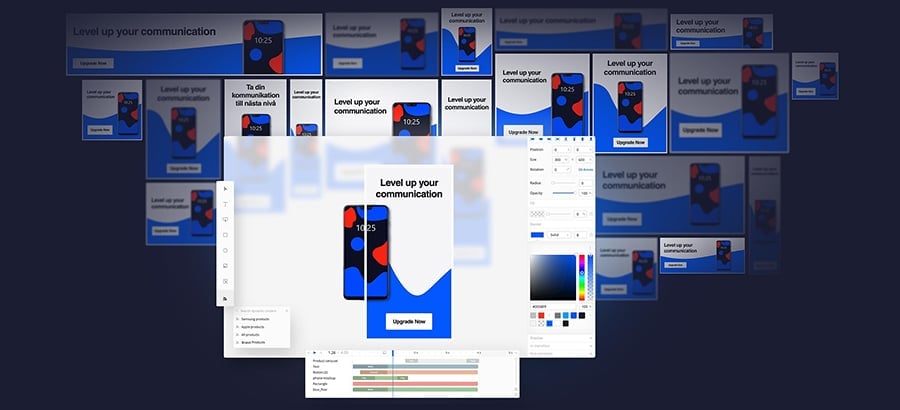In this blog, we provide a glossary for all the key acronyms and terms essential to understand display advertising. Make sure to return on a regular basis, as we add new digital advertising jargon.
Acquisition
Also referred to as a conversion. An acquisition is determined when a user signs-up, makes a purchase, or performs a desired action in response to an ad.
Ad agency
A company that provides services such as buying, tracking, creating, and planning ad campaigns on behalf of their client.
Ad exchange
A system through which advertisers, publishers, and networks buy and sell ad inventory.
Ad network
A company that serves as a broker between publishers and advertisers. Networks will typically aggregate a selection of unsold inventory and offer this to advertisers at a discounted rate.
Ad server
The system responsible for serving ad creatives to publishers and deciding which ad to serve. Ad servers may also track data on clicks, and other data, for publishers.
Ad tag
An ad tag is a piece of HTML5 that informs a users’ browser the dimensions, location, etc, of a display ad that will then be served on the publishers site. For instance:
<!– 970×250 English (Marketing) –><script src=”//cdn.bannerflow.com/bf-placements/5d4bd14849d4c74678401f9e?responsive=on&targeturl=” async></script>
Ad targeting
This refers to the practice of targeting an ad to a user based on either contextual, demographic or behavioural data.
Attribution
Attribution is the model that determines which ad is responsible for a conversion action. The most common model is the last view/last click framework but as ad tech advances, other models have become more popular.
Behavioural data
A collection of a user’s online actions, usually including what sort of website they might visit.
Bidding strategy
A bidding strategy is the way a buyer calculates a bid in an ad auction. It can mean bidding a flat CPM or bidding a variable price based on past clickthrough or conversion rates.
Contextual data
Information on the contents of the webpage that a user is viewing, usually used for ad targeting. For example, if the user is viewing a newspaper article about travel, an airline may wish to display on that page.
Conversion
When a user performs a desired action on a page. For example, signing-up for a newsletter, or making a purchase.
Cookie
Use HTTP cookies for tracking sessions, storing specific user info, and authenticating. HTTP Cookies comprise a parcel of text sent by a server to the cookie file in a browser. Advertisers can also use cookies to track the number and frequency of ads.
Creative management platfom (CMP)
A creative management platform (CMP) combines a variety of digital advertising tools into one, cloud-based platform. These tools include ad design builders capable of making dynamic creative at scale, instant publishing, and marketing data collection and analysis.
Creative management platforms are ideal to both create and control dynamic creative optimisation (DCO) campaigns. Enabling the production of more personalised ad experiences.
Data management platform (DMP)
A DMP, is a centralised system that gathers all first-party data. Using a DMP, third-party data can also be integrated and applied to an advertisers strategy. A DMP offers the following features: reach for particular segment; the ability to measure lift from using data; and assistance for publishers in monetising user data.
Demand-side platform (DSP)
A demand-side platform (DSP) is a system that allows buyers of digital advertising inventory to manage multiple bids through just one interface.
Dynamic Creative Optimisation (DCO)
Dynamic creative optimisation, is a form of programmatic advertising that allows digital advertisers to optimise the performance of their ad creatives using real-time technology.
Frequency capping
The act of limiting the number of times a particular ad can be served to a user. For instance, an advertiser might use frequency capping to ensure an ad is only served three times in 24 hours.
HTML5 banner ad
HTML5 is the latest update of the Hypertext Markup Language. Within a HTML5 banner ad, text, images, video, and JavaScript is adjustable in the same way as any web page – they are editable. HTML5 banner ads will dynamically optimise too, so the ad looks perfect everywhere.
Impression
A measure of the number of times an ad is served to a user.
In-banner video
Uses the normal space provided for a banner ad to deliver a video experience as opposed to another static or rich media format. It also relies on the existence of display ad inventory on the webpage for delivery.
Landing page
The page which a user “lands” on directly after clicking on an ad. For example, after clicking on ad for a rucksack they may be sent to a page URL, such as rucksack.com.
Programmatic buying
Buying via automatic means. For example, by setting up a campaign using real-time bidding (RTB) through an ad exchange. This is in direct contrast to a more manual system where an advertiser would be in direct contact with a sales team.
Publisher
A source of ad inventory. This can take the form of a blog, online newspaper, magazine or editorial.
Real-time bidding (RTB)
Bidding that occurs via automated auctions in real-time. A bid uses the past performance of ads, inventory, or user groups, etc, to generate dynamically.
Retargeting
The act of targeting a user who has performed an action in the past and who therefore, may be more likely to perform the same or similar task in the future. For example, an advertiser may wish to place a pixel on their shopping cart page of a website to retarget users and encourage them to complete a purchase.
Supply side platform (SSP)
The equivalent of a DSP for publishers. This allows them to access to demand from a variety of networks, exchanges, and platforms via one interface.
Viewability
This a measure of whether an ad has actually been seen by a given user. This is different from an impression, which measures how many times an ad was served. The javascript within each ad will show whether an ad is viewable based on a number of variables.
Display Advertising Glossary To Go!
Get our brand new glossary for all the key acronyms and terms essential to understand display advertising. Simply fill out your details below to get your copy now!
Want to know more?
In need of more essential display advertising information? Sign-up to receive the latest digital marketing content, delivered monthly to your inbox.
Subscribe to Bannerflow’s Digital Insider newsletter to read real-life success stories from leading brands, have your questions answered, and discover top techniques for achieving digital marketing ROI.
Or, if you would like to know more about the Bannerflow CMP, request a demo.







